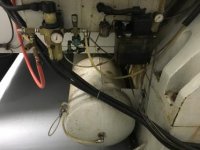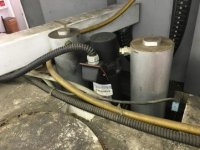pdexter1210
Aluminum
- Joined
- Oct 21, 2014
Our old (1995) VF6 has recently started hitting the umbrella on a tool change and alarming out. We've checked limit switches and they seem to be ok. The problem does not occur on every tool change, but it is occurring daily. We've looked at the Z height tool change setting, but given that the problem is intermittent, I don't feel like this is/should be the problem. When the machine alarms out, the Z shows a negative number, but when the tool change works good, the Z reading never drops below zero. While our machine is old, it is a low hour machine and has cut a lot of aluminum, so I'm hesitant to jump to the conclusion that was suggested by our HFO that our Z ball screw may be shot.
Other than checking encoder connections, checking for chips, are there other things we should be checking before we take more drastic measures? Thanks.
Edit to the post. Here is a pic from the operators screen when running a tool change that was going to crash. During a tool change operation where the spindle is going to crash into the umbrella the spindle move's up to machine zero, when the umbrella begins to move over towards the spindle, the the spindle starts to drop (by random amounts, never the same amount) until we hit E-stop in order to prevent the crash. The machine output position always reads the same as the operator input. The manual clearly states that during an M06 tool change that the Z axis remains at zero. Why would our machine be telling the spindle to drop during a tool change? More importantly, how do I make it stop? Thanks.

Other than checking encoder connections, checking for chips, are there other things we should be checking before we take more drastic measures? Thanks.
Edit to the post. Here is a pic from the operators screen when running a tool change that was going to crash. During a tool change operation where the spindle is going to crash into the umbrella the spindle move's up to machine zero, when the umbrella begins to move over towards the spindle, the the spindle starts to drop (by random amounts, never the same amount) until we hit E-stop in order to prevent the crash. The machine output position always reads the same as the operator input. The manual clearly states that during an M06 tool change that the Z axis remains at zero. Why would our machine be telling the spindle to drop during a tool change? More importantly, how do I make it stop? Thanks.

Last edited:










